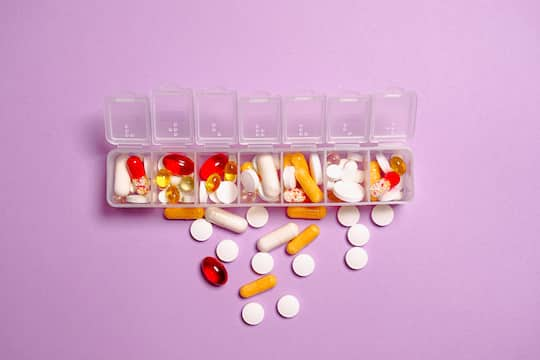These symptoms of vitamin D intoxication are from a case report of nutritional supplement overdosing.
Doctors are warning of increased hospitalization due to overdosing on supplements among athletes and the general public.
Misusing nutritional supplements can cause toxicity — known as hypervitaminosis — that can strike people at any age.
One recent medical report records how a middle-aged man was admitted to hospital with hypervitaminosis D and severe hypercalcaemia (high calcium levels).
His symptoms were:
- Repeated episodes of nausea and vomiting,
- abdominal pain,
- diarrhoea,
- leg cramps,
- weight loss,
- dry mouth,
- excessive thirst,
- and tinnitus (ringing in the ears).
The symptoms began 1 month after beginning a supplement regimen advised by a nutritional therapist.
The study’s authors wrote:
“Globally, there is a growing trend of hypervitaminosis D, a clinical condition characterized by elevated serum vitamin D3 levels.
It has been reported that hypervitaminosis D is more likely to occur in females, children, and surgical populations.”
The patient had been consuming large quantities of several nutrients every day containing:
- vitamin D 15 0000IU (recommended daily intake: 10μg or 400IU),
- vitamin K2 100μg (recommended daily intake: 100–300μg),
- omega-3s 4000mg (recommended daily intake: 200–500mg),
- magnesium malate 1000mg, magnesium citrate 1480mg,
- calcium orotate 1000mg,
- vitamin B3 50mg (recommended daily intake: 16mg),
- B9 1000μg (recommended daily intake: 400μg),
- choline + inositol 100mg,
- zinc picolinate 15mg,
- vitamin B2,
- vitamin B6,
- vitamin C,
- selenium,
- several amino acids,
- probiotics,
- sodium chloride,
- and glucosamine with chondroitin.
After experiencing sickness he stopped taking the supplements, but the symptoms still remained.
The doctors ran blood tests and found that the patient had very high levels of vitamin D, increased levels of calcium and magnesium, plus kidney injury.
The patient was kept 8 days in hospital, given intravenous fluid therapy, bisphosphonates (to reduce bone loss and calcium levels), and antiemetic drugs (to stop vomiting).
Two months later, at follow-up, his calcium levels were reduced but his vitamin D levels were still high.
The authors warn:
“Given its slow turnover (half-life of approximately 2 months), during which vitamin D toxicity develops, symptoms can last for several weeks.”
Patients might show different symptoms related to hypervitaminosis D such as
- apathy,
- confusion,
- sleepiness,
- depression,
- psychosis,
- coma,
- pancreatitis,
- peptic ulcers,
- abdominal pain,
- constipation,
- vomiting,
- anorexia,
- abnormal heart rhythm,
- high blood pressure,
- and kidney injury.
In some cases keratopathy (disease of the cornea), arthralgia (joint stiffness), and hearing loss have also been reported.
The authors concluded:
“This case report further highlights the potential toxicity of supplements that are largely considered safe until taken in unsafe amounts or in unsafe combinations.”
Generally, the recommended daily intake of vitamin D can be obtained from exposure to sunlight (ultraviolet light B helps the body to breakdown 7-dehydrocholesterol into vitamin D3) and some foods such as oily fish and wild mushrooms.
The study was published in the BMJ Case Reports (Alkundi et al., 2022).

